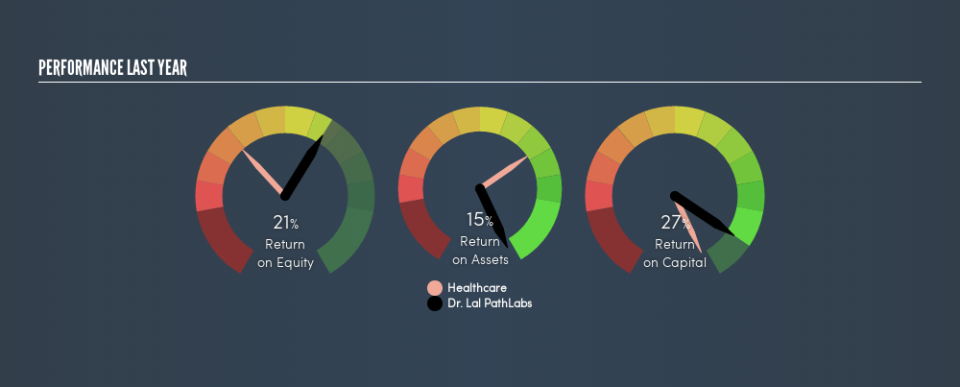A Close Look At Dr. Lal PathLabs Limited’s (NSE:LALPATHLAB) 27% ROCE

Today we are going to look at Dr. Lal PathLabs Limited (NSE:LALPATHLAB) to see whether it might be an attractive investment prospect. Specifically, we're going to calculate its Return On Capital Employed (ROCE), in the hopes of getting some insight into the business.
Firstly, we'll go over how we calculate ROCE. Second, we'll look at its ROCE compared to similar companies. Last but not least, we'll look at what impact its current liabilities have on its ROCE.
Return On Capital Employed (ROCE): What is it?
ROCE measures the amount of pre-tax profits a company can generate from the capital employed in its business. In general, businesses with a higher ROCE are usually better quality. Ultimately, it is a useful but imperfect metric. Author Edwin Whiting says to be careful when comparing the ROCE of different businesses, since 'No two businesses are exactly alike.'
So, How Do We Calculate ROCE?
The formula for calculating the return on capital employed is:
Return on Capital Employed = Earnings Before Interest and Tax (EBIT) ÷ (Total Assets - Current Liabilities)
Or for Dr. Lal PathLabs:
0.27 = ₹2.6b ÷ (₹11b - ₹1.4b) (Based on the trailing twelve months to March 2019.)
So, Dr. Lal PathLabs has an ROCE of 27%.
Check out our latest analysis for Dr. Lal PathLabs
Does Dr. Lal PathLabs Have A Good ROCE?
When making comparisons between similar businesses, investors may find ROCE useful. In our analysis, Dr. Lal PathLabs's ROCE is meaningfully higher than the 14% average in the Healthcare industry. I think that's good to see, since it implies the company is better than other companies at making the most of its capital. Setting aside the comparison to its industry for a moment, Dr. Lal PathLabs's ROCE in absolute terms currently looks quite high.
The image below shows how Dr. Lal PathLabs's ROCE compares to its industry, and you can click it to see more detail on its past growth.
When considering ROCE, bear in mind that it reflects the past and does not necessarily predict the future. ROCE can be deceptive for cyclical businesses, as returns can look incredible in boom times, and terribly low in downturns. ROCE is, after all, simply a snap shot of a single year. Future performance is what matters, and you can see analyst predictions in our free report on analyst forecasts for the company.
What Are Current Liabilities, And How Do They Affect Dr. Lal PathLabs's ROCE?
Short term (or current) liabilities, are things like supplier invoices, overdrafts, or tax bills that need to be paid within 12 months. The ROCE equation subtracts current liabilities from capital employed, so a company with a lot of current liabilities appears to have less capital employed, and a higher ROCE than otherwise. To counter this, investors can check if a company has high current liabilities relative to total assets.
Dr. Lal PathLabs has total assets of ₹11b and current liabilities of ₹1.4b. As a result, its current liabilities are equal to approximately 13% of its total assets. A minimal amount of current liabilities limits the impact on ROCE.
The Bottom Line On Dr. Lal PathLabs's ROCE
Low current liabilities and high ROCE is a good combination, making Dr. Lal PathLabs look quite interesting. Dr. Lal PathLabs shapes up well under this analysis, but it is far from the only business delivering excellent numbers . You might also want to check this free collection of companies delivering excellent earnings growth.
If you are like me, then you will not want to miss this free list of growing companies that insiders are buying.
We aim to bring you long-term focused research analysis driven by fundamental data. Note that our analysis may not factor in the latest price-sensitive company announcements or qualitative material.
If you spot an error that warrants correction, please contact the editor at editorial-team@simplywallst.com. This article by Simply Wall St is general in nature. It does not constitute a recommendation to buy or sell any stock, and does not take account of your objectives, or your financial situation. Simply Wall St has no position in the stocks mentioned. Thank you for reading.


